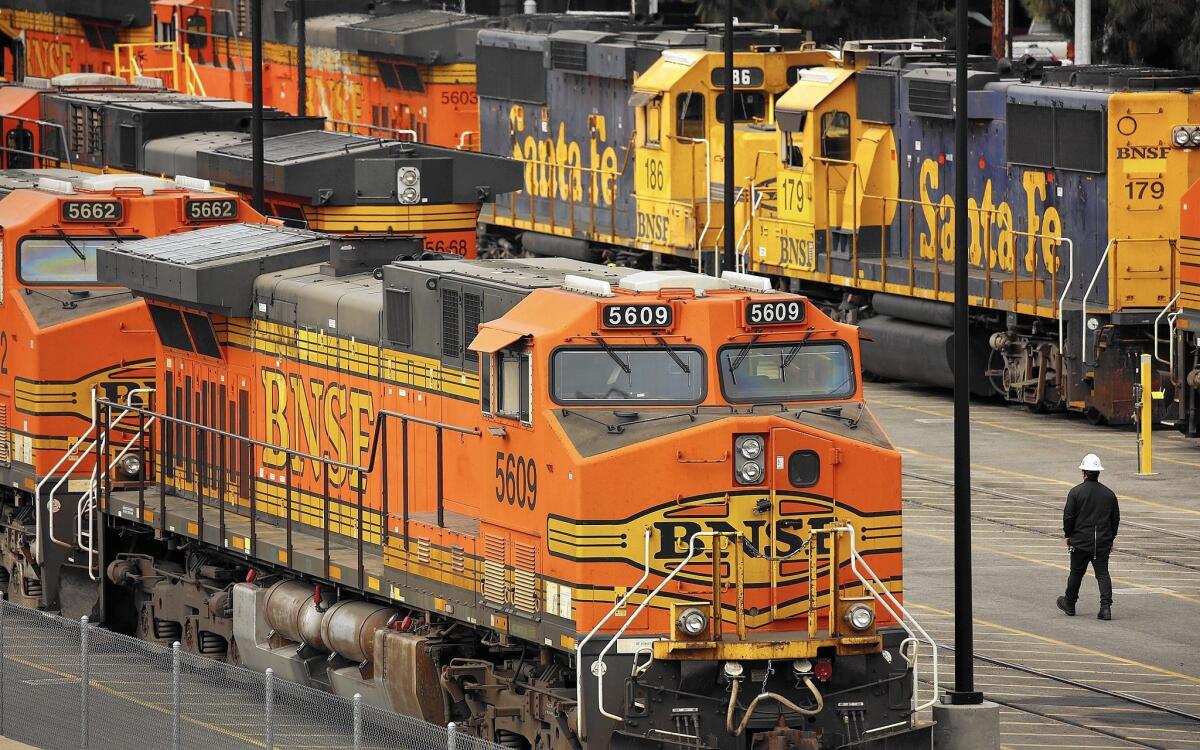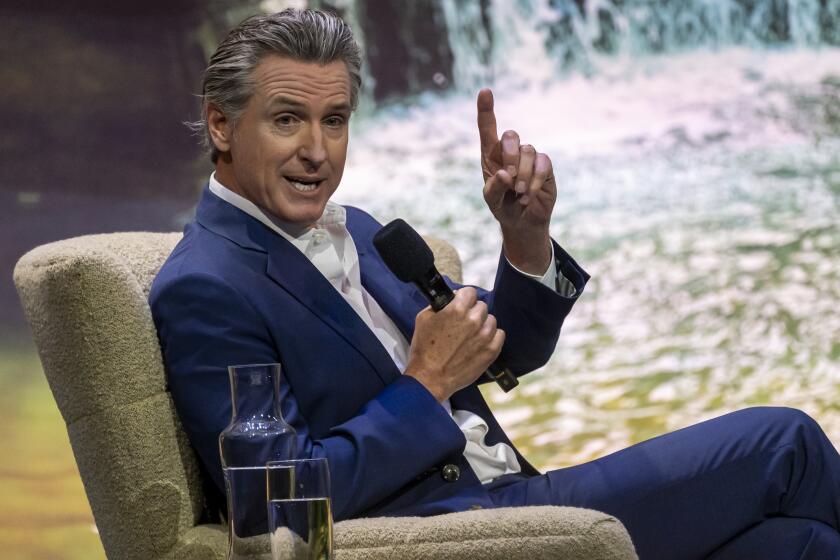Why most of the freight engines that Metrolink is leasing to improve safety are sitting idle

- Share via
After last year’s fatal collision with a utility truck near Oxnard, the Metrolink commuter railroad faced a serious safety issue. The cab car at the front of the ill-fated train did not meet design standards — a flaw that might have caused the derailment, which killed the engineer and injured 28 passengers.
As a hedge against a similar incident, Metrolink officials decided to place locomotives at both ends of trains until the railroad could solve problems with its new Hyundai Rotem cab cars — passenger coaches with an engineer’s position.
In October, Metrolink officials signed an $18-million-a-year lease with Burlington Northern Santa Fe Railway Co. for 40 freight engines. They hoped to put the locomotives into operation within weeks of their delivery.
Since then, most of the powerful freight engines have sat idle in Metrolink yards at a cost of $500 each per day, and many passengers still ride in the Hyundai cab cars.
“Safety concerns shaped the Burlington Northern Santa Fe locomotive lease,” said Art Leahy, the commuter line’s chief executive. “But implementation has been difficult. Safety has been increased but not as much as expected.”
Metrolink records show that the railroad placed an average of 13 freight engines into service per weekday in March. The daily high was 16 and the low was 10. The number in service in April dropped to an average of 12 per weekday with a daily high of 18 and a low of seven.
Leahy said he wants 30 Burlington Northern locomotives in operation by the end of May, while some remaining engines will be reserves. The cab cars that are replaced will continue to serve as passenger coaches, but not in the lead position where they are located when trains reverse direction at the end of lines.
Questions about the slow pace of deployment have been raised by several Metrolink board members and rail advocates, including Paul Dyson, president of the Rail Passenger Assn. of California and Nevada, as well as Los Angeles County Supervisors Michael D. Antonovich and Hilda Solis, who sit on the board.
Solis and Antonovich said they are concerned about the cost of the lease and the safety of passengers who continue to ride in the Hyundai cab cars. Antonovich also questioned whether a serious enough safety issue ever existed to justify the lease.
“Given the many months of delay in putting these locomotives into service, either our passengers have been exposed to danger without these locomotives on the lines and we should have shut down service,” Antonovich said, “or there was no real safety compromise to begin with, and the CEO saddled the agency with an expensive lease without proper board authority.”
Dyson contends the locomotive plan was not well thought out and that Metrolink board members do not have enough railroad experience to have adequately evaluated the use of freight engines on a passenger line.
But board member Keith Millhouse, who is a Moorpark City Council member, said the railroad has worked hard to get the locomotives into operation and that the agency has made sure the remaining cab cars in service are safe as possible.
“I ride in those cars in front. I don’t have a concern,” Millhouse said. “The Oxnard crash involved a freakishly rare set of circumstances. If there was a problem, I’d be screaming not to use those cars.”
Metrolink purchased 57 Hyundai cab cars as part of a $263-million package of new passenger coaches that replaced the railroad’s aging fleet of rolling stock. Equipped with impact-absorbing crush zones, the Hyundai cars are reputed to represent state-of-the-art rail safety.
Railroad officials decided in September to temporarily restrict the use of the cab cars after an internal investigation revealed that a device called a “pilot” was poorly welded to car bodies and did not meet design standards, including strength requirements. Pilots are steel deflectors located at the front of cab cars that keep debris and wreckage from getting under the wheels.
Investigators suspect, but have not yet proved, that the cab car’s defective pilot triggered the derailment of the Metrolink train that struck a utility truck and trailer that strayed onto the tracks at a rail crossing outside Oxnard on Feb. 24, 2015. The pilot broke away on impact, and all four passenger cars came off the tracks, three of which overturned.
According to a confidential Metrolink record obtained by The Times, inspections of the Hyundai cab cars uncovered defects in the pilots of at least 20 cars as of September. Rail officials declined to say how many of the 57 cab cars have been found to have flaws.
In early October, the Metrolink board approved $24 million to acquire the locomotives: $18 million for the lease and about $6 million for parts and other expenses.
Metrolink officials say they accepted 15 locomotives in October, 16 in November, two in December and sevenin early January. Lease payments begin for an engine when it is accepted after inspection.
Considerable time was required for repairs, road tests, maintenance and to link the engines to Metrolink’s positive train control system, a sophisticated tracking and collision-avoidance system that relies on global positioning technology, computers and digital communications.
Waivers for a certain type of braking system had to be sought from the Federal Railroad Administration. Parts for the freight locomotives had to be acquired, and engineers, operations and maintenance personnel needed training.
Once the freight locomotives started going into service, Metrolink officials said they encountered other problems that needed to be addressed.
Inaccurate speedometers triggered the positive train control system unnecessarily, which slowed or stopped trains, resulting in delays for passengers. Trains equipped with the larger engines didn’t always fit into sidings, they were slower than passenger trains and required more time at stations to load and unload passengers.
In addition, people who live near Metrolink lines or rail yards have complained about loud horns, and the heavier freight locomotives, which have far more traction than passenger engines, can cause excessive track wear — the metal shavings from which signals can short out.
“I wish we had more in service, but we are making progress,” Leahy said. “This was a bigger challenge than originally thought.”
Twitter: @LADeadline16
ALSO
Trump spurs a fresh wave of Latino activism
Sharpton: Larry Wilmore’s calling Obama the ‘N-word’ was in ‘bad taste’
On his Santa Monica mountaintop, a billionaire envisions lofty thoughts
More to Read
Sign up for Essential California
The most important California stories and recommendations in your inbox every morning.
You may occasionally receive promotional content from the Los Angeles Times.











